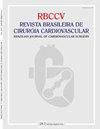儿科心脏移植:在巴西一家三级中心的初步经验
IF 1.2
4区 医学
Q4 CARDIAC & CARDIOVASCULAR SYSTEMS
Revista Brasileira De Cirurgia Cardiovascular
Pub Date : 2022-05-23
DOI:10.21470/1678-9741-2021-0483
引用次数: 0
摘要
引言儿童心脏移植是治疗终末期心力衰竭的有效方法。本文描述了我们在巴西一家三级中心进行儿童心脏移植的初步经验。变量显示为频率、平均值或中位数。借助Microsoft®Excel®2019和STATSDirect版本3.3.5获得统计分析和Kaplan-Meier精算曲线。结果2010年1月至2020年12月,10名儿童接受了双腔原位心脏移植,其中30%的儿童年龄在一岁以下。9名患者患有终末期心力衰竭(国际心肺移植学会心力衰竭D),50%的受试者在临床病情恶化的情况下进行了移植(机械辅助循环支持机构间注册≤2)。40%的受试者在虚拟交叉配型中具有>20%的群体反应性抗体。术后,80%的患者需要高剂量的肌力支持(血管活性肌力评分>10),持续时间>48小时。131个月时的无死亡生存率为77.1±14.4%。大多数患者(88.9%)在后期随访中出现活动性巨细胞病毒感染。44.4%的患者出现细胞排斥反应,有无临床反应。结论儿童心脏移植作为终末期心力衰竭的最终治疗方法,具有可接受和可行的疗效。本文章由计算机程序翻译,如有差异,请以英文原文为准。
Pediatric Heart Transplant: Initial Experience in a Tertiary Center in Brazil
Introduction Pediatric heart transplantation is the definitive therapy for children with end-stage heart failure. This paper describes our initial experience in pediatric heart transplantation in a tertiary center in Brazil Methods This is a historical prospective descriptive cohort study based on a review of the medical records of children undergoing heart transplantation at Hospital de Base and Hospital da Criança e Maternidade de São José do Rio Preto. Variables were displayed as frequency, mean, or median. Statistical analysis and Kaplan-Meier actuarial curve were obtained with the aid of Microsoft® Excel® 2019 and STATSDirect version 3.3.5. Results Between January 2010 and December 2020, ten children underwent bicaval orthotopic heart transplantation, 30% of which were under one year of age. Nine patients had end-stage heart failure (International Society for Heart and Lung Transplantation-Heart Failure D) and 50% of the recipients were transplanted under conditions of progressive clinical deterioration (Interagency Registry for Mechanically Assisted Circulatory Support ≤ 2). Forty percent of the recipients had a panel-reactive antibody > 20% on virtual crossmatch. In the postoperative period, 80% of patients required high dose of inotropic support (vasoactive-inotropic score > 10) for > 48 hours. The death-free survival rate at 131 months was 77.1±14.4%. Most patients (88.9%) in late follow-up had an episode of active cytomegalovirus infection. Cellular rejection, with or without clinical repercussion, was present in 44.4% of the patients. Conclusion Pediatric heart transplantation produces acceptable and feasible outcomes as definitive therapy for children with end-stage heart failure.
求助全文
通过发布文献求助,成功后即可免费获取论文全文。
去求助
来源期刊

Revista Brasileira De Cirurgia Cardiovascular
CARDIAC & CARDIOVASCULAR SYSTEMS-SURGERY
CiteScore
2.10
自引率
0.00%
发文量
176
审稿时长
20 weeks
期刊介绍:
Brazilian Journal of Cardiovascular Surgery (BJCVS) is the official journal of the Brazilian Society of Cardiovascular Surgery (SBCCV). BJCVS is a bimonthly, peer-reviewed scientific journal, with regular circulation since 1986.
BJCVS aims to record the scientific and innovation production in cardiovascular surgery and promote study, improvement and professional updating in the specialty. It has significant impact on cardiovascular surgery practice and related areas.
 求助内容:
求助内容: 应助结果提醒方式:
应助结果提醒方式:


